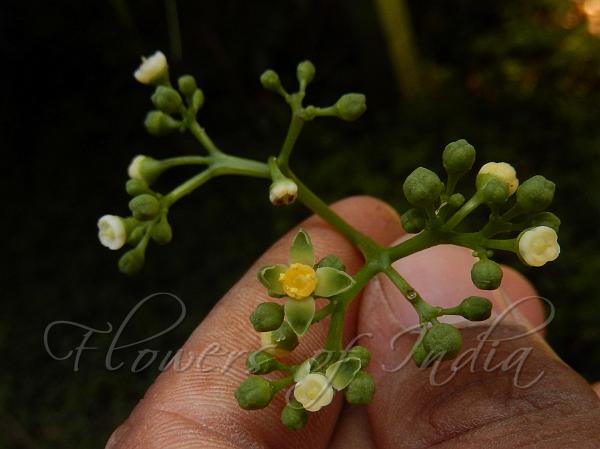|
| Birdfoot Grape-Vine |
|

|

| File size | 448087 |
| Original date | 10/14/15 9:41 PM |
| Resolution | 2048 x 1536 |
| Flash | Flash did not fire, auto |
| Focal length | 4.5mm |
| Exposure time | 1/100s |
| Aperture | 3.4 |
| Focus Distance | |
| Metering Mode | Multi-segment |
| Camera make | NIKON |
| Camera model | COOLPIX S9600 |
| Sensor type |
|
|
|
|
Photo: |
Botanical name: Cayratia pedata Family: Vitaceae (Grape family)
Synonyms: Vitis pedata, Cissus pedata, Cissus serratifolia
Synonyms: Vitis pedata, Cissus pedata, Cissus serratifolia
Birdfoot Grape-Vine is a large but week climbing
shrub, completely hairless. Tendrils are leaf-opposed, branched, wiry,
coiled. Leaves are alternate, pedately 5-7 foliolate, hairless; leaf
stalks 2-7 cm long; at branch-ends leaflets elliptic to
egg-shaped-lanceshaped, 5-12 x 3-6 cm, base rounded or pointed, tip
tapering, margin toothed with saw-like teeth, stalk 1-2 cm long;
lateral leaflets 2.5-9 x 1.5-5 cm, base unequal, stalk up to 1 cm long.
Flowers are bisexual, hairless, greenish yellow or yellowish white,
about 3 mm across, placed on about 10 cm long branched, in leaf-axils
corymbs. Berries are spherical, about 1 cm across, creamy white. Seeds
1-2, flat, semicircular, smooth. Birdfoot Grape-Vine is found in
Indo-Malesia. Flowering: March-June.
Medicinal uses: The whole plant of Nilgiri
Grape-Vine (excluding the roots) has low diuretic activity and has been
a reputed remedy for cough, bronchitis, asthma, joint pain and to check
uterine reflexes.
The whole plant of Nilgiri
Grape-Vine (excluding the roots) has low diuretic activity and has been
a reputed remedy for cough, bronchitis, asthma, joint pain and to check
uterine reflexes.
Medicinal uses:
 The whole plant of Nilgiri
Grape-Vine (excluding the roots) has low diuretic activity and has been
a reputed remedy for cough, bronchitis, asthma, joint pain and to check
uterine reflexes.
The whole plant of Nilgiri
Grape-Vine (excluding the roots) has low diuretic activity and has been
a reputed remedy for cough, bronchitis, asthma, joint pain and to check
uterine reflexes. | Identification credit: Siddarth Machado | Photographed in Niligiri Biosphere Reserve, Tamil Nadu. |
• Is this flower misidentified? If yes,